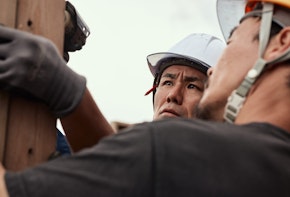“Nowhere is the exclusion of directly impacted communities more indefensible than in our democracy and policymaking process, the precise forums where decisions are made about how to prioritize, develop, and implement the solutions to our collective problems.”1
—Next 100
Parents and family members, early educators, child development experts, child care owners and directors, and children and their advocates all have a stake in how child care policy decisions are made. Failure to engage these stakeholders in the policymaking process has often resulted in inequitable policies that undervalue the work that providers do,2 and do not adequately meet the child care needs of families, especially those with low incomes and Black, Latinx, and other families of color.3
Ignoring the voices and concerns of caregivers, in particular, has deep roots in American policy. Caregiving has long been undervalued and exploited labor, starting with the immoral institution of chattel slavery that forced Black women to care for the children of white landowners to the detriment of their own children. Even after slavery was outlawed, domestic work, including caring for children in other people’s homes, was often one of the few occupations that laws and culture made available to Black women.4 For much of U.S. history, Black and immigrant women have disproportionately occupied positions in the field of child care.5 In addition, historically and today, families often rely on the unpaid labor of mothers to provide child care, reinforcing the misogynist and racist idea that child care is less valuable work6 because it is perceived as a woman’s role. This perception has further contributed to the lack of public investments in child care.
Today, the exclusion of caregivers and other stakeholders from conversations about child care policy design exacerbates inequities in the sector. By design, women, people of color, parents, people without wealth or high incomes, and child care providers are severely underrepresented in positions of power, including the government positions that influence child care policy investments. Bringing these diverse voices into the policymaking conversation increases the ability of these constituency groups to ensure that policy decisions result in equitable outcomes that value the needs of children and families and the work of child care providers. In addition to creating better policies, engaging stakeholders provides a pathway for them to buy into the success of the policies, which further bolsters their effectiveness. It can also be an opportunity for stakeholders to build power, develop mutual respect, engage in collective action, and build trusted relationships with policy makers that allow them to influence policy decisions on an ongoing basis.
Stakeholder Engagement in Child Care Policy
When the COVID-19 pandemic hit, child care programs shut down or reduced their capacity, and parents pulled their children from programs due to health concerns and struggled to manage work without child care.7 As the backbone of a sector already suffering from a chronic lack of public investment, child care providers were asked to do even more, including paying for protective equipment and additional cleaning supplies, often with fewer resources as a result of a system that typically pays based on attendance rather than enrollment. For early educators who already struggled with chronically low pay and lack of benefits, the added strain caused by the pandemic created new challenges that drove many away from the sector.
States that consulted directly with stakeholders, by building or strengthening relationships, were more likely to design a fair plan that targeted resources to Black, Latinx, and other communities who faced historic discrimination and exclusion and ensure money was distributed effectively and efficiently.
When Congress worked to address the pandemic-related child care challenges, first through the Coronavirus Aid, Relief, and Economic Security Act (CARES Act) and the Coronavirus Response and Relief Supplemental Appropriations Act (CRSSA Act), and then with $40 billion for child care and early education in the American Rescue Plan Act (ARPA), states were charged with distributing the funds.8 Research conducted for this report showed that states that consulted directly with stakeholders, by building or strengthening relationships, were more likely to design a fair plan that targeted resources to Black, Latinx, and other communities who faced historic discrimination and exclusion and ensure money was distributed effectively and efficiently. Meanwhile, states that did not were more likely to be out of sync with the true needs of the sector and communities and to exacerbate the effects of historic racism in the child care sector.
This report looks at five key lessons learned from how Michigan,9 North Carolina,10 and Mississippi11 engaged child care stakeholders in the distribution of their emergency child care funding granted as part of the COVID-relief packages passed by Congress in 2020 and 2021.
This report is based on research by the Center for the Study of Social Policy, which conducted dozens of interviews with advocates, providers, and administration members in each state in late 2021 through early 2022. That research indicated that, in North Carolina and Michigan, state administrators took affirmative steps to engage stakeholders in decision making around how to allocate and effectively distribute the funding, while in Mississippi, stakeholder engagement was much more restricted due to limited administrative capacity, among other factors. The conversations that took place as part of this research made it clear that when states commit to work closely with stakeholders, engagement in and of itself can advance racial justice and shows respect to a field that has been neglected and undervalued. The information shared in these interviews highlights how engaging stakeholders can help ensure the funding gets to the families and providers who need the support the most—and the harmful consequences of not engaging stakeholders.
For more on the findings from this research on the impact of federal relief on families, child care providers, and communities, see the three briefs published by the Center for the Study of Social Policy (CSSP):
Lesson 1
Building trust between stakeholders and policy leaders takes time and yields more effective policies.
Across the three states, it was clear that building relationships and trust between stakeholders and policy leaders is an ongoing process that can take significant time and effort, but when done well can provide a foundation for better policy making. In North Carolina and Michigan, dedicated efforts to build trust between state leaders and stakeholders had a positive impact. North Carolina had a strong early childhood network in place prior to the pandemic, including a public–private partnership of member organizations in every county. The network helped create strong communication channels connecting the Division of Child Development and Early Education (DCDEE) at the Department of Health and Human Services with providers. According to a senior official from DCDEE, stabilization grant outreach helped build on these existing relationships, creating an opportunity and infrastructure for “consistent communication between the state and the field that are not going to go away. That expectation is going to outlast COVID.”12
The North Carolina official explained that the increased communication was an opportunity for the government to build trust with child care providers. One of the most significant changes as a result of this trust building was that the department started treating providers as customers instead of entities to be regulated for compliance, significantly improving the relationship and the program.13 This is an issue in a lot of states, since the limited funding that is available for child care assistance means that states tend to tighten requirements for providers to receive funds rather than proactively distribute funds relatively quickly based on providers’ needs. This new framing of providers as customers rather than entities to be regulated will be incredibly helpful in improving the system and future trust.
Years of stakeholder engagement in North Carolina and a commitment to learn from past mistakes helped lead to this improved approach toward care providers. Challenges faced by providers with applying for and managing the earlier relief grants prompted the staff at DCDEE to conduct interviews with child care providers. In response to hearing that providers did not receive clear communication on how much money they were going to receive or who to go to for questions, they built up their customer service tools. The willingness of the state officials to learn from mistakes and humbly address them helped to solidify the trust with stakeholders.
The willingness of the state officials to learn from mistakes and humbly address them helped to solidify the trust with stakeholders.
Similarly in Michigan, willingness to listen and learn from past mistakes helped build trust between state leaders and stakeholders. After initial missteps in the first round of COVID-19 funding in Michigan, state leaders actively worked to improve stakeholder engagement. With the CARES Act grants, Michigan leaders had rushed to get the funding out the door, leading to miscommunication and decision-making that exacerbated inequities. For example, the original grant did not provide bonuses to providers who accepted subsidies, and excluded providers who had lower or no quality star ratings (which themselves can perpetuate racial inequity because under-resourced, particularly Black and Brown child care providers are less likely to meet criteria such as employing a high percentage of caregivers that have a bachelor’s degree). Once the administration engaged with stakeholders, they learned what they needed to do better with the ARPA dollars to more effectively get the grants to providers who most needed them. As a senior administration official explained, “We tried to create a grant criteria that felt fair and we took our grant structure on the road. We did a ton of work on it before the legislature passed the budget and met with small groups of providers to get their feedback so that hopefully we can get a good endorsement from partners who have a following, networks, et cetera, in the state to be able to say, my voice was a part of this.” One Detroit-based child care provider reflected the feeling of being seen and respected by saying that the new bonus structure would, “honor and acknowledge programs who were taking care of subsidy children.” The administration owned its mistakes and engaged as genuine partners with stakeholders, fostering authentic and frequent dialogue about what the American Rescue Fund distribution plan should include, building trust and better policy.14
Meanwhile, in Mississippi, prior to the pandemic, onerous regulations and callous administrative decisions had fostered an environment of distrust between the state and parents and providers. A previous administration’s attempt to require fingerprinting for parents accessing child care subsidies (while unsuccessful) increased tensions between providers and the state, because state officials impugned the character of providers as “untrustworthy.” According to one advocate, “the whole idea of fingerprinting among a Black population with a white state agency imposing this requirement, it just felt so deeply offensive.” The role of racism and sexism in these sorts of decisions was lost on no one, and engendered distrust that has hampered the child care sector and left the Mississippi Department of Human Services ill-equipped to distribute federal funds in ways that might advance equity, be accessible to providers, and meet the needs of children and families. When COVID relief funding came with perfunctory stakeholder engagement that did not take seriously the feedback received, it heightened this distrust.15
Lesson 2
Developing partnerships improves implementation.
When states invest in developing strong partnerships with stakeholders, it allows for more successful implementation of policy. In Michigan and North Carolina, stakeholders were important partners in outreach, helping policy leaders effectively reach a wider array of communities. For example, in Michigan, the advocacy community hosted provider fairs to recruit and support potential child care providers applying for grants, working closely with state leaders. The advocates were able to use their relationships to give technical assistance to providers to ensure that they (a) knew how and when to apply for stabilization grants and (b) continued to accept children receiving subsidies. They also helped set up coalitions at the local level to provide feedback on implementation to the administration. Advocates engaged with the legislature and the state administration and together, as one advocate reflected, “tried to take a holistic look at our child care needs and boost funding on both the supply, as well as the demand side.”16
The Michigan leaders also acknowledged that including more stakeholders in the process of outreach and technical assistance allowed them to reach more people.
The Michigan leaders also acknowledged that including more stakeholders in the process of outreach and technical assistance allowed them to reach more people. The stakeholders the state engaged are trusted messengers in the community and have the capacity to provide accessible training and to translate applications into and provide technical assistance in multiple languages. As a result, stakeholder engagement in Michigan supported providers and advocates to not only be a valuable part of the design of the funding opportunity, but also to improve the effectiveness of the implementation and get more equitable results.17
North Carolina’s stakeholder engagement was similarly intensive. The state was in regular contact with coalitions and networks to get input about different ways to structure the stabilization grant program. According to the DCDEE official, “The number of touchpoints that we’ve had with our provider communities is amazing and is unprecedented. Our child care providers have never had this kind of access to the state and vice versa.”18
The stakeholder feedback in North Carolina led to better customer service and also resulted in better policy implementation. The state hired a customer service team, created a dedicated email address, contracted with a communications firm to support outreach efforts, and worked with the early childhood network to host regular sessions for providers leading up to the application roll out. In addition, DCDEE did user testing to make sure that the application process was not a barrier for providers, and used the application process as a way to collect data to help the department track disparities in the types of providers who applied and the populations served by those providers (and which providers and populations were missing out on available resources).19
Meanwhile, in Mississippi the lack of trust and partnership made it harder to implement the policies effectively and created a dearth of communication. Providers, who had experienced a feeling of chronic disrespect, feared they would have to pay the money back or be under strict scrutiny of the state and were less likely to apply for the grants.20
Lesson 3
Supports from outside the state, such as federal and philanthropic resources, can help establish sustainable stakeholder engagement infrastructure.
Support from the federal government and philanthropy can be a critical catalyst to developing sustainable stakeholder engagement infrastructure. In Michigan and North Carolina, both philanthropic and new federal dollars were used together to support stakeholder engagement. Prior to the pandemic, child care stakeholders in Michigan had little access to the governor’s office and communication to the field, if any, went through only one channel. After initial missteps in the first round of COVID-19 funding, state leaders actively worked to improve stakeholder engagement. State-based philanthropies facilitated “institutions of trust” between the state and providers, and the administration owned its mistakes and engaged as genuine partners with stakeholders by attending convenings regularly and being just a phone call away.21
North Carolina had a strong early childhood network in place prior to the pandemic, in large part because of the existing Smart Start Network, a public–private partnership, and the Child Care Resource and Referral network. The NC Partnership for Children, a statewide nonprofit, supports the seventy-five local partnerships in the Smart Start Network, which are providing services and programs to all children, prenatal to age 5, in North Carolina’s one hundred counties. These networks helped create strong communications channels connecting the Division of Child Development and Early Education (DCDEE) at the Department of Health and Human Services with providers.22
The federal dollars built on these philanthropically funded networks in North Carolina to establish stronger engagement infrastructure. As one leader said, it created a “clearer pipeline for those conversations to go back and forth between us and DCDEE.” Advocates met every week, with DCDEE joining once-a-month. These calls gave advocates an opportunity to make sure they were on the same page and shared a “united voice” about policy, such as the importance of salary and benefit increases for child care workers. These activities created stronger coalitions, built relationships between policy makers, advocates and providers, and strengthened the power of key stakeholders to ensure equitable distribution of funds.23
The decision not to put federal dollars to use bolstering the state’s capacity to administer the new funding made things even more challenging.
In Mississippi, on the other hand, federal dollars were not used to develop sustainable infrastructure to engage stakeholders and administer programs. One of the issues that stakeholders consistently raised was the lack of staff capacity to administer child care funding at the state’s Department of Human Services. Given the understaffing in normal times, it was even harder during this emergency to rely on the state to serve the child care sector and families. The decision not to put federal dollars to use bolstering the state’s capacity to administer the new funding made things even more challenging. DHS did not provide the technical assistance or support for providers and added more burdens when they required them to file reports to “close out” the CARES Act funding before ARPA stabilization grants were released. The lack of staff capacity to distribute federal funds contributed to ongoing feelings of exclusion for Black and low-income families and providers.24
The decision not to put federal dollars to use bolstering the state’s capacity to administer the new funding made things even more challenging.
Stakeholders in Mississippi also wished the state would improve their data infrastructure and invest in making the case for future spending by tracking outcomes of the relief and child care spending. In a catch-22, one advocate acknowledged “We don’t think state investment is going to happen for us. Especially if we can’t show an impact.” Yet advocates did not believe the state would invest in the data needed to show impact.25
Lesson 4
Leadership from the governor’s office and at the cabinet level is crucial to ensure stakeholder engagement is woven throughout the process of determining and implementing child care spending priorities.
In order for stakeholders to be engaged at every step in the state policy making process and actually shape decision making, leadership from the governor’s office is critical. In both Michigan and North Carolina, key staff in the governor’s office and administration were committed to greater equity and interested in forming positive relationships with stakeholders to help achieve that. They were able to access and use the resources from the federal government, the state, and philanthropy to foster stakeholder engagement directly with the administration to create a more effective and equitable distribution of funds. In Mississippi, that was not the case.
In Mississippi, advocates blamed the governor’s office and legislature for disfavoring any increased human services spending. For providers, this meant they felt disregarded and undervalued by state officials, unheard by state administrators, and disrespected. For parents, this meant they felt they were viewed prejudicially as welfare recipients, had difficulty accessing quality care, and faced numerous administrative burdens, such as strict recertification to maintain access.
Lesson 5
Stakeholder engagement is a powerful mechanism to advance economic, racial, and gender equity.
Stakeholder engagement can help advance equity by bringing historically marginalized communities who are also often those most directly impacted by policy decisions into the decision-making process. Genuine stakeholder engagement that builds trust and long-term relationships by listening and taking seriously the feedback of those impacted leads to both a better process and a better outcome.
In Michigan and North Carolina, where stakeholders were effectively engaged and had a meaningful role in the design and distribution of COVID-relief child care funding, the policy decisions led to better, more equitable outcomes. For example, in North Carolina, the first wave of stabilization grants ($336 million)26 went to 90 percent of eligible child care programs, with 88 percent of those who received grants using it to strengthen compensation for their workforce.27 In Michigan, according to the Governor’s office, 58 percent of approved stabilization grant funds were issued to “areas of highest need,”28 which include most of the major population centers for Black residents in Michigan.29 The share of providers receiving bonuses for equity-related measures was very high, and closely tracked the share of providers eligible for those bonuses. For example, 40 percent of programs who received stabilization grants received bonuses for caring for children who receive a subsidy, and 41 percent of all providers care for children with subsidies. Similarly, 45 percent of programs received bonuses for caring for children with special needs, compared to 47 percent of all providers who care for the special needs population, and 23 percent received bonuses for offering care during non-traditional hours, compared to 24 percent of all providers who provide care during those hours.30
In Michigan and North Carolina, where stakeholders were effectively engaged and had a meaningful role in the design and distribution of COVID-relief child care funding, the policy decisions led to better, more equitable outcomes.
Meanwhile, the lack of effective stakeholder engagement in Mississippi reinforced the lack of equity in their policy making. Because of the structure of the grant, which did not take providers’ and advocates’ feedback into account and required providers to spend down the money faster than they thought was realistic, stakeholders worried that providers would unintentionally become out of compliance with the grant terms and suffer financial repercussions as a result. Instead, the lack of communication, trust, and transparency that existed before the pandemic persisted throughout it as well, and thus impeded efforts to advance equity through the stabilization grants.31
Looking Forward
Engaging stakeholders in decision making ensures policy is more responsive to the needs of families and communities, during times of crisis and at all times. It is also a precondition for advancing racial, gender, and economic justice. The failure to effectively engage stakeholders, as in Mississippi, often perpetuates historic and systemic discrimination and inequities. At the same time, successfully fostering stakeholder engagement, as in Michigan and North Carolina, builds the foundation for lasting change. Moving forward, policymakers should take steps to strengthen the infrastructure and build more formal stakeholder engagement processes into child care policy work in every state.
Notes
- Francisco Miguel Araiza, Suryani Dewa Ayu, and Emma Vadehra, “Inclusive Policy Research and Policy Development with Impacted Communities:A Toolkit for Think Tanks, Policy Nonprofits, and Governments,” Next 100, 2022, https://thenext100.org/reports/inclusive-policy-research-and-policy-development-with-impacted-communities/.
- Gina Adams and Eleanor Pratt, “Executive Summary: Assessing Child Care Subsidies through an Equity Lens,” Urban Institute, September 2021, https://www.urban.org/sites/default/files/publication/104776/executive-summary-assessing-child-care-subsidies-through-an-equity-lens_1.pdf.
- Rasheed Malik, “Investing in Infant and Toddler Child Care to Strengthen Working Families,” Center for American Progress, October 21, 2019, https://www.americanprogress.org/article/investing-infant-toddler-child-care-strengthen-working-families/.
- Premilla Nadasen and Tiffany Williams, “Valuing Domestic Work,” New Feminist Solutions Series, Barnard Center for Research on Women, 2010, http://bcrw.barnard.edu/wp-content/nfs/reports/NFS5-Valuing-Domestic-Work.pdf.
- Premilla Nadasen and Tiffany Williams, “Valuing Domestic Work,” New Feminist Solutions Series, Barnard Center for Research on Women, 2010, http://bcrw.barnard.edu/wp-content/nfs/reports/NFS5-Valuing-Domestic-Work.pdf.
- Julie Vogtman, “Undervalued A Brief History of Women’s Care Work and Child Care Policy in the United States,” National Women’s Law Center, 2017, https://nwlc.org/wp-content/uploads/2017/12/final_nwlc_Undervalued2017.pdf.
- Julie Kashen, “States Are Stepping Up with Emergency Child Care Solutions for Frontline Essential Personnel in Response to COVID-19,” The Century Foundation, April 30, 2020, https://tcf.org/content/commentary/states-stepping-emergency-child-care-solutions-frontline-essential-personnel-response-covid-19/.
- Alycia Hardy and Katherine Gallagher Robbins, “Child Care Relief Funding in the American Rescue Plan: State-by-State Estimates,” Center for Law and Social Policy, March 2021, https://www.clasp.org/wp-content/uploads/2022/01/2021_American-Rescue-Plan-CC-Relief-Funding-State-by-State-Estimates_updated-March-2021.pdf.
- Ellie Kaverman, Elisa Minoff, and Julie Kashen, “A ‘Godsend’: How Temporary Investments in the Child Tax Credit and Child Care Impacted Michigan Families,” Center for the Study of Social Policy, March 2022, https://cssp.org/resource/a-godsend-how-temporary-investments-in-the-child-tax-credit-and-child-care-impacted-michigan-families/.
- Ellie Kaverman and Elisa Minoff, “Where Do We Go From Here?: How Temporary Investments in the Child Tax Credit & Child Care Impacted North Carolina Families, and the Road Ahead,” Center for the Study of Social Policy, July 2022, https://cssp.org/resource/where-do-we-go-from-here/.
- Ellie Kaverman and Elisa Minoff, “‘We Don’t Have that in Mississippi’: How Temporary Expansions of the Child Tax Credit & Child Care Demonstrate the Importance of Federal Investments & Oversight,” Center for the Study of Social Policy, June 2022, https://cssp.org/resource/we-dont-have-that-in-ms/.
- CSSP Interview with North Carolina leaders, 2021.
- Ibid.
- CSSP interviews with Michigan leaders, 2021.
- CSSP interviews with Mississippi leaders, 2021.
- CSSP Interviews with Michigan leaders, 2021.
- Ibid.
- CSSP Interviews with North Carolina leaders, 2021.
- Ibid.
- CSSP interviews with Mississippi leaders, 2021.
- CSSP interviews with Michigan leaders, 2021.
- CSSP interviews with North Carolina leaders, 2021.
- Ibid.
- CSSP interviews with Mississippi leaders, 2021.
- Ibid.
- Press Release: “Governor Cooper Announces Over $335 Million Distributed to More Than 3,900 Child Care Centers Through Child Care Stabilization Grants,” North Carolina Governor Roy Cooper, February 10, 2022, https://governor.nc.gov/news/press-releases/2022/02/10/footage-available-governor-cooper-announces-over-335-million-distributed-more-3900-child-care.
- CSSP interviews with North Carolina leaders, 2021.
- As determined by Office of Child Care in its B-5 Plan to develop alternative funding models for child care. https://www.michigan.gov/documents/mde/Stabilization_Grant_data_flyer_final_v3_745281_7.pdf.
- https://mlpp.org/wp-content/uploads/2021/03/michigan.pdf ; https://www.bridgemi.com/michigan-government/michigan-more-integrated-ever-some-fear-more-white-flight-will-follow.
- CSSP interviews with Michigan leaders, 2021.
- CSSP interviews with Mississippi leaders, 2021.












